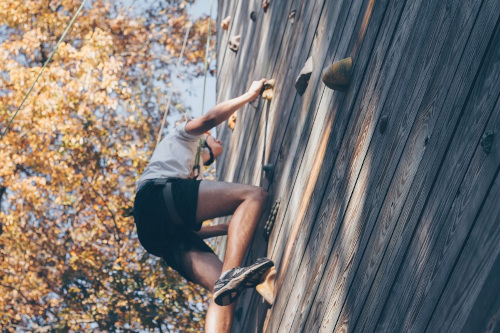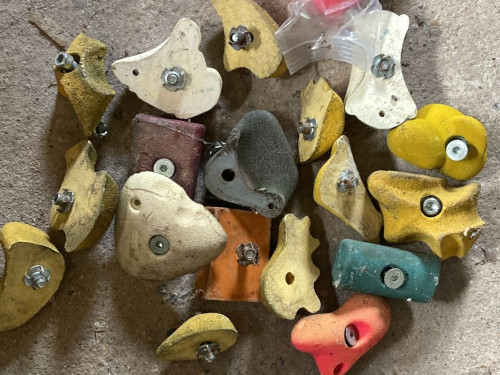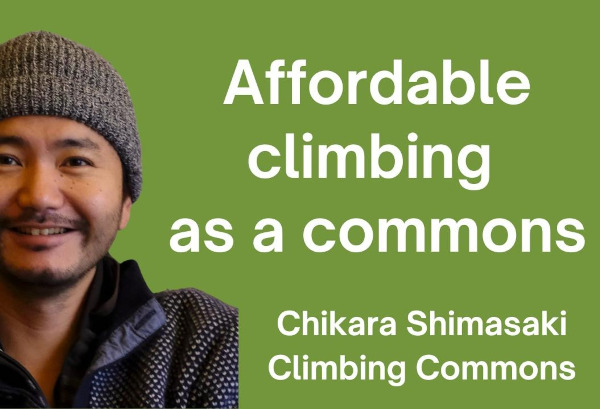Today we’re talking with Chikara Shimasaki, who’s building a climbing commons in Stroud, and will provide information for anyone wanting to do it in their own towns.
Dave: before we talk about what you’re doing – what’s the problem you’re trying to solve? What’s your motivation?
Chik: the climbing commons group was set up when I started to get involved with Stroud Commons. When I began to understand the funding model – the future use vouchers. I recognised that in the climbing world, people buy monthly or yearly passes – i.e. paying for future use. I thought that if it was small enough, on the community level, you could get enough people to buy vouchers / climbing passes for one or two years to be able to build a climbing gym.
D: so there isn’t a climbing gym in Stroud?
C: no – people have to drive for half an hour to an hour each way, and paying £12-15 each time to climb. I’ve got a young family and I can’t afford the time and money. If I could set up a gym in Stroud that’s affordable and I could walk or cycle to, it would certainly meet my needs! And it turns out there are a lot of people who want it. Initially I just spoke to a few people about the idea, and about 5 of us started to roll the project forward. Soon we realised we needed more data. We created a survey, and talked to people at the market on Saturday etc. How many people would be interested, how much would they pay, what else would they like to see – bouldering? Food and drinks? How frequently they’d use it. Plus we asked for a postcode, so we could see where people were, so we could think about where to locate the gym.
D: but you’re not talking about any old climbing gym – you’re talking about a commons / community-owned climbing gym?
C: yes – the idea was that if we can crowdfund the building, we should be able to reduce the entry price. The vision was ‘accessible climbing for all’. Climbing gyms are expensive, so many people are excluded by price and distance they need to travel. By commoning it, we could bring down the price, and with a few new ideas, we’ve brought it down to about half the price of for-profit gyms.
D: how?
C: first, the size of the gym matters. The crowdfunded amount can afford roughly 6-700 square feet of space in Stroud, although we’re hoping to scale up slowly. But the size means that the capital required is quite small, and the number of users is just enough that it can be affordable. The funding model reduces interest payments and risks associated with going into debt. The biggest reduction came from seeing that there are lots of key-card gyms around the world, but none officially in the UK.
D: this is unstaffed climbing gyms? You just turn up with a key-card and let yourself in?
C: yes – that reduces the cost and risk of employing people. We’ll still have opening hours when I’ll be there, with other core members, but at some times it will only be accessible via key-card. This will massively reduce overheads, and make the facility affordable. We negotiated with 2 or 3 insurance companies for about 6 months to get the idea accepted.
D: and what’s different about the commons idea? Who will own the gym? How does it work?
C: at the moment we’re a small core group of 8 people, but we’ve also got about 70-80 volunteers in a whatsapp group. The group includes builders, architects, electricians etc. Lots of different people with different skills who are waiting for the project to start and they can chip in when needed. There’s also a lot of experienced climbers, well-networked in the climbing industry. Then there’s the wider public who will come and use it. The survey discovered over 600 people, and I’m sure there are more in Stroud. Once it transitions to full commons governance, the core group will become the ‘steward’ group who will oversee operations.
D: so the stewards will be employees?
C: it depends on how well that model develops. Initially it will be volunteer-run. In years 2 and 3 we’ll transition to some staff being paid. We’ll see. The governance of it is interesting. We’re hoping to have a users group, a stewards group, and if we get more external interest, then also an investors group. There will also be a ‘custodian’ group to make sure that assets don’t get sold out of commons ownership.
D: how do you choose those custodians?
C: they need to be external, so they’re not involved in either the operations or use, and they’re not investors. They’re a third party who understand the commoning model enough to be able to veto any decisions that jeapordise / violate commons principles.
D: so with no vested interest?
C: yes
D: how are they chosen? Would they be more on the experienced climbing side of things, or the commons side of things?
C: commons. They don’t need to be a climber. It’s more about understanding Ostrom’s principles and the value of commons – being able to discern what would be a risk to the commons. Someone with business sense and understanding of commons.
D: I guess people are going to ask ‘who owns it?’ Your average climbing gym will be an ordinary business. Who owns this?
C: it’s a multi-stakeholder organisation. The steward group is a company limited by guarantee, but the company wouldn’t hold assets like the building, equipment etc. – that would be owned by the association. So if the business side (the company) fails, the assets will remain in community ownership.
D: in perpetuity?
C: yes. In climbing, the assets / equipment depreciate fast. So the perpetuity aspect is more important in commons like housing, where the value holds for tens if not hundreds of years. But in principle we want to protect the assets, so that if it goes bust, the assets could maybe distributed to local schools etc.
D: I guess you don’t want to have volunteers build things like a climbing gym, only to be bought out by a big corporation later on, taking money out of Stroud.

C: yeah – that’s the key idea. Right now, money paid for climbing by people in Stroud is leaving the town. We can help keep it circulating within Stroud. Interestingly, there’s a big climbing gym being set up about 25 minutes’ drive away. We’ve been in conversation with them, positioning ourselves as complementary. Because we’re a small non-profit with half-price entry, we can act as an entry funnel to new climbers to try it out and access the sport. We could then be developing customers for bigger gyms. We could work in partnership with bigger gyms – for example, this new one has offered to lease us their holds, and we’re thinking of maybe setting up joint membership, so our membership gives benefits / access to the larger gym for example. Then it becomes replicable in any other community moving forward.
D: so the big boys are not hostile towards you – don’t see you as damaging competition?
C: exactly.
D: how far have you got / what successes have you had?
C: we’ve been at it for about 2 years, and the group began to grow when we found a location – the design process and costing went ahead. But the amount crowdfunded was enough to build about 70% of the walls we envisaged, and operate for about 2-3 months. For some of us, we thought that in those 2-3 months, we could bring in more people. We knew there were more people willing to put money in when it was open. But in the end we decided to back away, due to the risks involved. We started looking at grant funding to plug the hole – but to apply for grant funding we needed a location, so it was a Catch 22 situation. So recently, we’ve been talking with the Grace Network / Long Table, a social impact organisation, who managed to get a long-term lease on their local property. We’ve handed in a proposal – if they accept, they’ll be a really good landlord, who can help us set the pilot up and trial it.
D: so how are you getting on with looking for grants?
C: we applied to UnLtd. Which is a charitable org that funds social impact startups, providing business support, training and grants. We got to the panel meeting stage, and we know there’s a lot of competition to get to panel meetings, so we’re hoping we might get that.
D: how much?
C: £8k – not enough, but it’s a start – and they don’t mind if we don’t have a location, which is good. As and when the Long Table agrees to host us, we can get a draft lease that will allow us to apply for other grants.
D: how much have you raised directly from climbers / investors?
C: £20k. About £18k came in within the first 5 days. Stroud has a crowdfunding platform part-funded by the district council, and round 2 is happening around Feb-March. Because we’ve already crowdfunded, we can show the community engagement and the desire for this to happen. And at the Long Table, we’d reach many more people, who might invest.
D: so for their money, investors get passes / vouchers for climbing in future – individual sessions or annual passes?
C: at the moment – we’ve got an unlimited annual pass. Come and climb any time you like, as many times as you like, for £300.
D: how does that compare to private gyms?
C: they’re around £500 for the same thing. So it’s considerably cheaper. We’ve also got other tiers, from occasional to single-use vouchers – so for example, ten sessions / passes for £75. So £7.50 per entry.
D: when do you think this gym might exist?
C: it depends on the response from the Long Table. If that works, we’re hoping to get it up and running by June. We’ve got the capacity, the design, and we’ve solved all the hard problems, like biometric/fingerprint entry, insurance, induction model that allows inductees to be ‘floor-walkers’, and other things have been worked through, so it’s just getting it built and working. So I think it could be quick once we get the go-ahead.
D: how did you find out about these commons ideas, and what attracted you to them?
C: I was looking for some solutions to the problems that we’re all facing. I went down a lot of different rabbit-holes.
D: what kind of rabbit-holes?
C: from more global solutions – policies, energy infrastructures, distribution / transport infrastructure, to community development and internal stuff – healing of trauma etc. And linking them all up for meaningful transition to a more sustainable world.
D: someone said to me, when I told them about a potential commons climbing gym in Stroud, ‘well, that’s not really central to the economy’. What would you say to that?
C: two ways to answer that. 1. I thought this could be an easy ‘Trojan Horse’ to get the commons model up and running, for people to see the benefit. A flagship project. But also 2. I think leisure / having fun is critical in making change happen. But at the moment, I work in front of a screen, then pay a private gym to lift weights and run on a treadmill, which is horrible. I’d much rather be climbing.
D: what do you see as the biggest barriers, and how do you remove them or get around them?
C: for us, I think that by end of year two, we’ll be well into profit (surplus). But the first year will be a challenge – to cover capital and operations costs. Then we’ll start generating a surplus. So as long as we have the membership numbers we think we will, we’ll be oversubscribed, and we might have to scale up more quickly than we’d like. But the size of the pilot stage doesn’t justify having paid staff, so I guess that limits the ability to have open days and other ways for the general public to engage with climbing. That’s a limitation of the pilot stage model, and we don’t want to rely on volunteers for too long – a year max. We’ve already spent 2 years with the core group chipping in thousands of hours. We’d like to transition to a paid model quickly, by sustainably scaling.

D: what’s the ambition? Would you like to help people do this in other towns, or have a bigger centre in Stroud, or both?
C: both – but not that big. Just big enough to have full-time paid staff and serve all our members, especially those who may not be able to climb otherwise. That might not be too big. The other aspect is the replicability. We started with the core idea that it would be replicable. We didn’t want it to be too complex. So soon, we’ll put all the research into a toolkit / playbook so that other communities can follow it A-B-C to set up a climbing gym that’s insurable, complies with regulatory frameworks, and we can provide all of our policies too.
D: all free of charge?
C: of course, yes.
D: so anyone watching/reading this who thinks this might be a good idea for their community can contact you and you can provide them with the tools to do it?
C: not quite there yet, but happy to chat. Hopefully within a year we’ll have something ready.
D: great. How do people follow what you’re up to / your latest news?
C: you can subscribe on climbingcommons.org to receive monthly newsletters.
D: what’s the difference between climbingcommons.org and the Stroud Commons website?
C: the reason we set up climbingcommons.org was that as climbing commons appear in other towns, we’d love the climbing commons site to be developed well enough that other communities that don’t have the web development capacities can have climbingcommons.org/coventry (etc.) as their website.
D: so that’s going to be a national website in time?
C: that’s the idea. Stroud Commons will be Stroud specific, but climbingcommons.org can support other climbing groups.
D: what do you need in Stroud? More investors, volunteers, potential customers? How can people join in?
C: right now it feels as though we have enough volunteers and people willing to help. It really comes down to the next crowdfunding stage. If you’d like this to succeed, put a bit of money in.
D: how do people do that?
C: go to climbingcommons.org and buy the passes – click on ‘pricing’. We’ll initiate a new round of crowdfunding in the new year, once the location is settled. So that campaign will start soonish. But if you’d like to become an investor, contact me directly via the contact page on either website.
D: are you feeling optimistic?
C: it’s been a roller-coaster ride, but we’ve had a chat with the CEO of the Association of British Climbing Walls, and she said that we’re solving a lot of the issues that the climbing industry has seen for many years – affordability, accessibility. It’s encouraging for someone so involved with climbing in the UK to see us as doing something really innovative. We’d like to get to the point where we can say ‘this is working’ and to take it to other communities.
D: one last random question – who would you like to see interviewed, and what would you like to ask them?
C: climbing?
D: commons.
C: my background is working for the Organisation for Identity & Cultural Development, which is an org that specialises in human identities and conflict transformation. I’d love to interview the director to get to the nuts & bolts of how we could use the methodologies and technology have been developed for de-radicalisation and de-weaponising of identities to help build the commons. There’s a lot going on in the background at the moment.
D: that sounds like a great idea. I’ll put links to everything we’ve talked about in the description / article. Great talking with you. Cheers Chik.
C: bye.
Highlights
- Climbing gyms are expensive, so many people are excluded by price and distance they need to travel. By commoning it, we could bring down the price and distance.
- Climbing commons is owned by a multi-stakeholder association drawn from the community, with asset locks so it will remain community-owned forever, and can’t be bought out by a big company.
- Stroud Climbing Commons will produce toolkits / playbooks for others to do the same in their community.
- You can support this by becoming an investor / potential user.


Leave a Reply